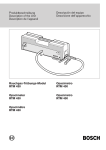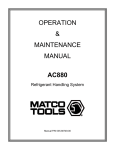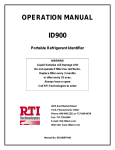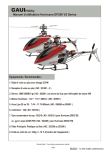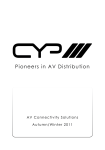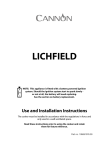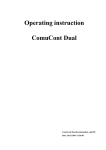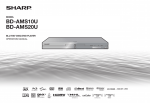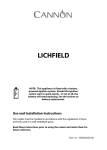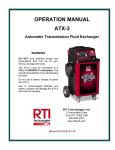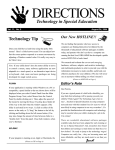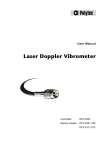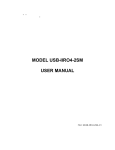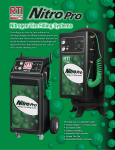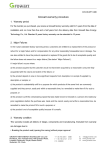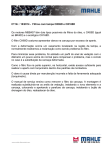Download RHS1280 - MAHLE Service Solutions
Transcript
RHS1280 EN Original instructions AC Service Units en 2 | RHS1280 | 2RHS1280 Contents 1. 1.1 1.2 2. 2.1 2.2 2.3 2.4 2.5 3. 3.1 3.2 3.3 3.4 3.5 Symbols used In the documentation 1.1.1 Warning notices—Structure and meaning 1.1.2 Symbols in this documentation On the product 4 4 4 4 4 Important notes User group Agreement Obligation of contractor Safety regulations 2.4.1 RHS1280 2.4.2 Refrigerant identification unit Safety devices 4 4 4 5 6 6 7 8 Product description Application Scope of delivery Description of unit 3.3.1 Selection and function keys 3.3.2 Input keys 3.3.3 Printer 3.3.4 Service doors 3.3.5 Scales for used oil and refrigerant 3.3.6 Service quick-release couplings 3.3.7 Inline filters 3.3.8 Locking caster brakes 3.3.9 Power supply cable and switch Refrigerant identification unit 3.4.1 Delivery Functional description © MAHLE 8 8 8 9 10 10 11 11 12 12 12 12 12 13 13 13 4. 4.1 4.2 4.3 4.5 Commissioning Removing transportation packaging Attaching handles RHS1280 4.3.1 Setting language 4.3.2 Setting date and time 4.3.3 Setting workshop data 4.3.4 Activating / deactivating printer, workshop info, buzzer, operator list 4.3.5 Maximum service data records Checking type of connection of external refrigerant bottle Filling internal refrigerant bottle 5. A/C service preparation 17 Operation Service phases My database Refrigerant identification unit 6.3.1 Refrigerant analysis 6.3.2 Decontamination 6.3.3 Refrigerant verification 6.4 Automatic A/C service 6.5 Manual A/C service 6.6 Automatic/manual vehicle A/C service overview 6.6.1 Recovery 6.6.2 Vacuum 6.6.3 Charging with refrigerant 6.7 Flushing after changing type of oil 6.8 Draining service hoses 6.9 Setting service parameters 6.10 Non-condensable gases 6.11 System leak test 18 18 18 18 18 19 19 19 20 4.4 6. 6.1 6.2 6.3 14 14 14 15 15 15 15 15 15 16 16 20 20 20 20 21 21 21 21 21 | ������������ ������������� | 3 7. 7.1 7.2 Troubleshooting RHS1280 Refrigerant identification unit 22 22 24 8. 8.1 8.2 8.3 Maintenance Maintenance interval Maintenance protocol Calibration of scales 8.3.1 Calibrating internal refrigerant bottle 8.3.2 Calibrating used oil bottle scale Calibration check Taring of Scales Replacing inline filters Vacuum pump 8.7.1 Changing vacuum pump oil 8.7.2 Resetting oil change interval Combo filter 8.8.1 Changing Combo-Filter 8.8.2 Resetting filter replacement interval Software update Replacing printer paper Replacing white sample filter (Refrigerant identification unit) Changing the fuse System information Service report Spare and basic replacement parts 8.15.1 RHS1280 8.15.2 Refrigerant identification unit 25 25 25 25 25 25 25 25 26 26 26 26 27 27 28 28 28 8.4 8.5 8.6 8.7 8.8 8.9 8.10 8.11 8.12 8.13 8.14 8.15 en 28 28 28 28 29 29 29 9. 9.1 9.2 9.3 9.4 Disposal Disposal of electronic parts Disposal of LCD screen Disposal of refrigerants, UV dye, lubricants and oils Disposal of combo filter 29 29 29 10. 10.1 10.2 10.3 Technical data RHS1280 Refrigerant identification unit Electromagnetic compatibility 30 30 30 30 11. Glossary 30 12. Notes 31 29 29 © MAHLE en 4 | RHS1280 | Symbols used 1. Symbols used 2. 1.1 In the documentation Before start up, connecting and operating RTI products it is absolutely essential that the Original instructions/owner’s manual and, in particular, the safety instructions are studied carefully. By doing so you can eliminate any uncertainties in handling RTI products and thus associated safety risks upfront; something which is in the interests of your own safety and will ultimately help avoid damage to the device. When an RTI product is handed over to another person, not only the original instructions but also the safety instructions and information on its designated use must be handed over to the person. 1.1.1 Warning notices—Structure and meaning Warning notices warn of dangers to the user or people in the vicinity. Warning notices also indicate the consequences of the hazard as well as preventive action. Warning notices have the following structure: KEY WORD – Nature and source of hazard! Consequences of hazard in the event of failure to observe action and information given. hh Hazard prevention action and information. Warning symbol The key word indicates the likelihood of occurrence and the severity of the hazard in the event of non-observance: Key word Probability of occurrence Severity of danger if instructions not observed DANGER Immediate impending danger Possible impending danger Possible dangerous situation Death or severe injury WARNING CAUTION 1.1.2 Death or severe injury Minor injury Symbols in this documentation Symbol Designation 2.1 Important notes User group The product should only be used by skilled and instructed personnel only. Personnel scheduled to be trained, familiarized, instructed or to take part in a general training course may only work with the product under the supervision of an experienced person. The equipment should not be operated or serviced by any person who has not read all the contents of this manual. All work conducted on pressurized equipment may be performed by persons with sufficient knowledge and experience in the field of refrigeration, cooling systems and coolants and, also be aware of the risks involved in the use of pressurized devices. Explanation m Attention Warns about possible property damage. 2.2 t Information By using the product you agree to the following regulations: 1. 2. Multi-step operation One-step operation Intermediate result Final result Practical hints and other useful information. Instruction consisting of several steps. 1.2 Instruction consisting of one step. An instruction produces a visible intermediate result. There is a visible final result on completion of the instruction. On the product mmObserve all warning notices on products and ensure they remain legible. hh Wear protective goggles. hh Wear protective gloves. © MAHLE Agreement Copyright Software and data are the property of RTI or its suppliers and protected against copying by copyright laws, international agreements and other national legal regulations. Copying or selling of data and software or any part thereof is impermissible and punishable; in the event of any infringements MAHLE Aftermarket Inc., Service Solutions reserves the right to proceed with criminal prosecution and to claim for damages. Symbols used | ������������ ������������� | 5 Liability All data in this program is based—where possible—on manufacturer and importer details. RTI does not accept liability for the correctness and completeness of software and data; liability for damage caused by faulty software and data is ruled out. Whatever the event, RTI liability is restricted to the amount for which the customer actually pays for this product. This disclaimer of liability does not apply to damages caused by intent or gross negligence on the part of RTI. Warranty The RHS1280 includes a Warranty Card in the included documents. Visit the website (www.rtitech.com) and fill out the warranty information or return the completed card to activate technical support service and warranty coverage. Any use of non-approved hardware and software will result in a modification to our product and thus to exclusion of any liability and warranty, even if the hardware or software has in the meantime been removed or deleted. No changes may be made to our products. Our products may only be used in combination with original accessories and original service parts. Failing to do so, will render null and void all warranty claims. This product may only be operated using RTI approved operating systems. If the product is operated using an operating system other than the approved one, then our warranty obligation pursuant to our supply conditions will be rendered null and void. Furthermore, we will not be held liable for damage and consequential damage incurred through the use of a non-approved operating system. 2.3 en Obligation of contractor The contractor is obliged to ensure that all measures geared towards the prevention of accidents, industrial diseases, laborrelated health risks are taken and measures towards making the workplace fit for people to work in are carried out. Specifications for electrical systems (BGV A3) Electrical engineering in Germany is subject to the accident prevention regulations of the trade association "Electrical Plant and Equipment as under BGV A3 (previously VBG 4)". In all other countries, the applicable national regulations acts or decrees are to be adhered to. Basic rules The contractor is bound to ensure that all electrical equipment and operating material is set up, modified and maintained by skilled electricians only or under the guidance and supervision of a skilled electrician in accordance with electrical engineering principles. Furthermore, the contractor must ensure that all electrical equipment and operating material is operated in keeping with electrical engineering principles. If a piece of electrical equipment or operating material is found to be defective, i.e. it does not or no longer complies with electrical engineering principles, the contractor must ensure that the fault is rectified immediately and, in the event that imminent danger exists, also ensure that the electrical equipment or the electrical operating material is not used. Tests: yy The contractor must ensure that all electrical systems and equipment are tested by a qualified electrician or under the guidance of a qualified electrician to ensure they are in proper working order: —— Before starting for the first time. —— After modification or repair before starting for the first time. —— At given intervals. Set intervals such as to ensure that faults that can be expected to occur are determined in good time. yy The test is to take the electrical engineering principles relating hereto into account. yy Upon request of the trade association, a test manual is to be maintained into which specific entries are made. © MAHLE en 6 | RHS1280 | Symbols used 2.4 Safety regulations 2.4.1 RHS1280 Always carefully study and follow all the safety regulations before using the RTI product. Avoid all skin contact with the refrigerant. The low boiling point of the refrigerant (approx. –30 °C) can lead to frostbite. Should refrigerant come into contact with the skin, remove any moistened clothing immediately and rinse the area of skin affected with generous amounts of water. yy Avoid all skin contact with the UV dye. Should UV dye come into contact with the skin, remove any moistened clothing immediately and rinse the area of skin affected with generous amounts of water. yy R1234yf is colorless, with weak characteristic smell and heavier than air. It may flow into repair pits. Should refrigerant escape, provide for sufficient ventilation (particularly in repair pits) and leave the workshop. Never inhale refrigerant, dye and oil vapors. Avoid breathing refrigerant or lubricant vapor as the vapors can irritate the eyes, nose and respiratory system. If liquid refrigerant or UV dye comes into contact with the eyes, rinse them thoroughly with water for 15 minutes. Then obtain medical attention even if no pain is felt. Ventilate work area if accidental discharge occurs. yy Refrigerant extracted from a vehicle air conditioning yy yy yy yy yy yy If high-voltage components or high-voltage wires are handled incorrectly, there is a risk of fatal injury from high voltage and the possible transmission of current through the body. yy De-energizing is only to be performed by a qualified electri- yy yy Never swallow UV dye. Should it be swallowed inadvertently, never attempt to induce vomiting. Drink generous amounts of water and obtain medical attention. yy Before connecting the RHS1280 to a vehicle air conditioning system or an external refrigerant bottle, make sure the quick-release couplings are not leaking. Only ever use external refrigerant bottles provided with safety valves and certified inline with the applicable standards. yy Before switching off the RHS1280, make sure all charging and drainage operations have been completed. This prevents damage to the unit and reduces the risk of refrigerant escaping into the environment. Never use compressed air with R1234yf. Certain mixtures of air and R1234yf are highly flammable. Such mixtures are a potential hazard and may lead to fire or explosions and thus cause damage or injury. © MAHLE system may be contaminated with moisture, lubricant, dirt and traces of other gases. The RHS1280 is provided with a refrigerant identification system designed to prevent contamination with other refrigerants. If the refrigerant has been contaminated by being mixed with other gases, remove the contaminated refrigerant and add fresh R1234yf before using the RHS1280 for A/C service. R1234yf is not to be used in areas in which there is a danger of explosion. Fire, open flames and smoking are prohibited. Welding and soldering are not permitted. The RHS1280 unit should not be exposed to excess moisture or be operated in wet areas. High temperatures and UV radiation may chemically separate R1234yf. The resultant products can cause coughing and nausea. R1234yf is not to be mixed with other refrigerants. The mixing of refrigerants could damage the vehicle air conditioning system. yy yy yy yy yy cian, a qualified electrician for specific tasks (hybrid) or a power systems engineer. Work on vehicles with high-voltage components is only ever to be performed in a safe, de-energized condition by persons with the minimum qualification "Trained to perform electrical work". Even after deactivating a high-voltage vehicle electrical system, the high-voltage battery may still be live. Operating condition cannot be established from any running noise, as the electric machine is silent when stationary. In gear positions "P" and "N" the engine or electric motor may start spontaneously depending on the charge of the high-voltage battery. Never open or damage high-voltage batteries. On vehicles that have been in an accident, never touch high-voltage components or exposed high-voltage wires before deactivating the high-voltage vehicle electrical system. Symbols used | ������������ ������������� | 7 yy The RHS1280 must be constantly monitored when in yy yy yy yy yy yy yy yy yy yy yy yy yy yy yy yy operation. Never leave the RHS1280 unattended when in operation. Vehicle A/C service using the RHS1280 must be prepared and implemented such that the vehicle air conditioning system circuit does not have to be opened (for example by removing the radiator or engine). Position the RHS1280 on all four wheels on a flat, vibrationproof surface so that proper operation of the scales is guaranteed. The RHS1280 can be secured in position by locking the caster brake. The RHS1280 must always be transported in its operating position. Never lay the RHS1280 on its side, as oil could then escape from the vacuum pump or the built in compressor could be damaged. There are no additional safety systems for protecting the RHS1280 against damage resulting from natural catastrophes. Never remove any components from inside the RHS1280 except for maintenance or repair purposes. Follow the pertinent legal regulations or directives to ensure safe handling of pressurized devices. We recommend calibrating the scales at least once per year. Contact customer service for calibration of the scales. The RHS1280 must be subjected to regular maintenance by service personnel or authorized agents to ensure the safety of the unit. Disconnect power before performing any maintenance or service to the unit. Never perform any maintenance work which is not expressly recommended in this manual. Contact customer service if components have to be replaced other than in the course of maintenance work. RHS1280 must be connected to a properly grounded electrical connection. If there is damage to the RHS1280, terminate usage immediately and contact customer service. The service hoses and service quick-release couplings must be regularly checked for wear and replaced if damaged. The RHS1280 must be operated in an environment that will provide at least four air changes per hour. Observe local laws or directives as to ensure the safety of the pressurized device. en yy For safety reasons it is advisable to use a residual current operated circuit breaker (rccb) with the following specifications: Parameters Specification Rated voltage Rated frequency Rated current Rated tripping current Tripping switch 120 VAC ± 10% 50/60 Hz 12.5A 30 mA C yy Avoid using an extension cord with the unit. If necessary, use a good condition (three wire grounded, #14AWG or larger) extension cord of the shortest possible length. In addtion, the current drawn by all devices connected to the wall socket must not exceed 15A total. 2.4.2 Refrigerant identification unit yy Inspect the outside diameter of the white sample filter element before and after each use of this unit. As soon as red spots begin to appear on any portion of the white element outside diameter, the filter requires replacement. Failure to replace the filter when so indicated may result in damage to the identification unit (out of warranty). yy This unit requires connection of the sample fitting to the LP side port of the source vehicle or refrigerant cylinder. Connection of the test hose to the high, or liquid, port of the source vehicle or refrigerant bottle will result in damage to the unit (out of warranty). yy Inspect the test hose before and after each use of the unit. Immediately replace the hose if it appears cracked, obstructed, or fouled with oil. yy Never use a test hose other than those approved for use with the Identifier. yy Never connect the Identifier to any refrigerant source that exceeds 300 psi pressure. © MAHLE en 8 | RHS1280 | Product description 2.5 Safety devices Description Function Housing switch If one of the covers is removed from the RHS1280, all operations are terminated and the RHS1280 is disabled until the removed cover has been re-attached to the RHS1280. Service door switch If the service door of the RHS1280 is removed, the RHS1280 stops all processes and starts service mode. The built-in ventilation fan remains in operation to ensure that any R1234yf vapors which may have accumulated in the RHS1280 housing (e. g. on replacing the dry filter) are extracted from the service area. Air flow sensor The RHS1280 contains an air flow sensor which detects whether or not there is a sufficient flow of air in the housing of the RHS1280. Pressure switch Switches the compressor off if the normal operating pressure is exceeded. Safety valve The safety valve opens if the design pressure is exceeded. Fuse Interrupts the power supply if overcurrent is applied to the RHS1280. Vents The RHS1280 is provided with vents in the bottom of the housing to ensure the exchange of air even when switched off. 3. Product description 3.1 Application RHS1280 is suitable for vehicles with a conventional engine as well as for hybrid and electric vehicles. The RHS1280 features all the functions required for vehicle A/C service. The following functions can be implemented: yy Refrigerant recovery and recharging. yy Refrigerant conditioning. yy Vacuum generation. yy Flushing. yy Refrigerant identification. mmThe RHS1280 can only be operated with R1234yf. The RHS1280 is not to be used for service work on vehicles with air conditioning systems employing refrigerants other than R1234yf, as this will cause damage. Prior to A/C service check the type of refrigerant used in the vehicle air conditioning system. 3.2 Scope of delivery Description Handle (2) Handle rubber mount Service hose (high pressure) Service hose (low pressure) Quick-release coupling (high pressure) Quick-release coupling (low pressure) Used oil bottle Original instructions Quick manual Roll of paper for printer Adapter (external bottle) US ACME 0.5" Calibration check ball Inline filters (2) Integrated refrigerant identification unit Flushing adapter Fuses - 12.0A (Qty 4 - 2 installed in unit, 2 spare) May be included in delivery, depending on the version ordered 1) © MAHLE Product description | ������������ ������������� | 9 3.3 Description of unit Fig. 1: Front view 1 Handle 2 Display and operating unit 3 RHS1280 housing 4 Service door/document holder 5 Service hose 6 High-pressure quick-release coupling 7 Low-pressure quick-release coupling 8 Front wheel 9 Service door for used oil 10 High- and low-pressure connections 11 Main switch Fig. 2: 1 2 3 4 5 6 7 8 9 en Back view Mount for display and operating unit Service door/document holder Vacuum pump oil filler inlet Vacuum pump oil drain Rear wheel with locking caster brake Power supply cable inlet Fan Refrigerant Identifier Power supply cable holder © MAHLE en 10 | RHS1280 | Product description 8 The status and warning light (Fig. 3, Pos. 8) indicates the service status: 7 1 _M M 2 99 30 - 03 3 45 4 6 Fig. 3: 1 2 3 4 5 6 7 8 5 Status and warning light display color Maintenance status Red light Flashing green Green light Error/warning Operation in progress Operation completed/Attention Operator RTI supplies a USB stick for updating the RHS1280 software. If required, the USB stick can be inserted in the USB socket to perform updating of the firmware/software. NN Refer to Section 8.9 for detailed information on the software updating procedure. Display and operating unit High-pressure gauge LCD Input keys USB socket Selection and function keys Printer Low-pressure gauge Status and warning light The display and operating unit can be raised, lowered and locked in three different positions. 3.3.1 Selection and function keys Keys Name Function O OK Confirm and store Function depends on current menu Back Cancel Back one menu level or cancel Up or down control or or Enter Confirm and store C i Delete Information Deletes character to left of cursor Show current data Switching between number and letter input. Current mode is shown at bottom right of screen. Right or left control Various functions are assigned to the function keys in the RHS1280 software. The functions of the keys are defined in the menu line of the RHS1280 software. 4598 97_ 7Nkv Fig. 14: Raising display and operating unit Pull the mount from under the operating unit and lock in position at the securing points. The pressure gauges (Fig. 3, Pos. 1, 7) of the display and operating unit are used to monitor the pressure during the individual vehicle A/C service phases. The status of the various service phases during maintenance is displayed on the multicolor LCD screen (Fig. 3, Pos. 2). The necessary entries are made by way of the input keys (Fig. 3, Pos. 3) on the keypad. The selection and function keys (Fig. 3, Pos. 5) on the keypad are used to control the operator interface menu options. © MAHLE 3.3.2 Input keys The input keys can be used to enter letters, numbers and special characters in the input boxes. If a key is pressed several times in succession in the input box, all the characters which can be used for this are displayed. Product description | ������������� �������������� | 11 3.3.3 en NN The service door on the front permits access to the used Printer oil bottle. NN Service reports can be printed out. mmProtect thermal printer paper against direct sunlight, heat,oils, greases, tanning agents and materials containing plasticizers (e.g. PVC folders). 45 98 97 _4 Nk v 1 Fig. 6: Fig. 5: 2 Opening service door on front Printer 1 Cover 3.3.4 Service doors To open the service door at the right/left cover, remove the two locking screws and take out the service door. NN There are three service doors: One on the right side, one on the left side and one on the front of the housing. NN The service door compartments can be used for storing 1 459897_1 NN The service doors are fitted with contact switches. If one 3-1_MM documentation. Tools can be placed on the upper cover. of the service hatches is removed, the RHS1280 switches automatically to maintenance mode and will not provide A/C service functions. The RHS1280 returns to the main menu on refitting the service doors. NN The service doors on the side provide access to the vacuum pump, the internal refrigerant bottle and the filter drier. Fig. 7: Removing service door 1 Locking screws NN The built-in ventilation fan of the RHS1280 remains in operation when the RHS1280 switches to service mode to remove potentially flammable R1234yf refrigerant vapors which may have accumulated in the housing during A/C service. mmNever attempt to operate the RHS1280 without service doors, as this would make the working area dangerous. The housing of the RHS1280 was designed with a built-in ventilation fan to prevent the accumulation of potentially flammable R1234yf refrigerant vapors. © MAHLE en 12 | RHS1280 | Product description 1 3.3.5 Scales for used oil and refrigerant There are various scales for checking the quantities of refrigerant and used oil. 2 mmDo not exert excessive force when removing or inserting the used oil bottle, as this could damage the scale. Used oil bottle NN To remove the used oil bottle, pull the connection (Fig. 8) upwards slightly and detach the bottle downwards. 459897_14 Nkv 1 459897_39Nkv Fig. 9: Fig. 8: Removing used oil bottle 1 Connection Symbol Description Used oil bottle 3.3.6 Service quick-release couplings Unfastening quick-release coupling 1 Parking couplers 2 Service quick-release coupling To connect the coupling, position the coupling on the parking coupler, pull back the knurled section of the coupling element and press carefully onto the connection. 3.3.7 Inline filters The service hoses are connected to the RHS1280 by way of the inline filters. The inline filters prevent the ingress of fine particles into the internal hydraulic circuit of the RHS1280. NN The service quick-release couplings are connected to the service connections of the vehicle air conditioning system during A/C service. When not in use, the service quick-release couplings can be connected to the parking couplers. NN To remove the service quick-release couplings from the parking coupler, (Fig. 9, Pos. 2), press the coupling slightly towards the connection and carefully pull the knurled section back to unfasten it from the parking coupler. 1 2 3 4 Adapter for connection Filter element Adapter for hoses Sealing ring 3.3.8 Locking caster brakes Rolling of the RHS1280 can be prevented by locking the caster brakes (Fig. 2, Pos. 5) at the rear wheels. 3.3.9 Power supply cable and switch The power supply cable is connected to the main power input. When not in operation, the power supply cable can be coiled up on the cable holder on the back of the RHS1280. The RHS1280 is switched on by moving the main switch in clockwise direction to the vertical position. © MAHLE Product description | ������������� �������������� | 13 3.4 Refrigerant identification unit 3.5 en Functional description The refrigerant identification unit permits precise determination of the type of refrigerant as to prevent cross contamination by other refrigerants. The refrigerant recovered from the air conditioning system passes through the combo filter to remove suspended particles and moisture. mmOnly after successful identification of refrigerant, service The purpose of the vacuum pump is to generate a vacuum in the air conditioning system and to detect possible leaks in the vehicle air conditioning system. hoses may be connected to the vehicle. NN The refrigerant identification unit is incorporated into the service procedure and thus always to be used for A/C service. 3.4.1 Delivery Used oil separated from the vehicle refrigerant recovered drains into the used oil bottle. Oil removed from the vehicle A/C system compressor oil during the recovery process should be manually injected into the A/C system prior to recharging the system. The vehicle air conditioning system is partly filled with UV dye to facilitate the detection of leaks in the event of damage to the vehicle air conditioning system. The refrigerant in the internal refrigerant bottle is used for filling the vehicle air conditioning system. The purging unit for the non-condensable gases, consisting of a temperature sensor, pressure sensor, solenoid, and orifice, always takes effect when the internal refrigerant bottle pressure is higher than the saturation pressure. Refrigerant identification is a menu-driven process implemented by a refrigerant identification unit which is actuated by way of a USB connecting cable. Fig. 10: Refrigerant identification unit—delivery 1 Refrigerant identification unit 2 White sample filter © MAHLE en 14 | RHS1280 | Commissioning 4. Commissioning NN All the operations described in Section 4 must be performed prior to first A/C service. 4.1 4.2 Attaching handles 1. Take the handles out of the packaging. 2. Attach the rubber mounts (Fig. 11, Pos. 1). 3. Insert the end of the handle in the rubber mount. Removing transportation packaging NN When removing the packaging surrounding the refrigerant bottle, make sure the hoses of the internal refrigerant bottle do not come into contact with the housing or filter drier. 1. Remove the cardboard box. 2. Remove the parts under the RHS1280. 3. Remove the RHS1280 from the packaging pallet. 4. Remove the right side access hatch and remove and discard the foam isolation material. NN Do not unplug any electrical connections and only have 1 internal components opened and repaired by trained customer service personnel. NN Contact customer service in the event of any transportation Fig. 11: Inserting handle in rubber mount 1 Rubber mount damage (e.g. oil leakage). 4. Position the flange at the other end of the handle over the chassis bolt holes. 459897_1Nk v 459 897 1 _2N Fig. 12: kv Positioning handle on chassis 1 Flange 5. Bolt the handle to the flange. 6. Attach the second handle in the same manner. © MAHLE Commissioning | ������������� �������������� | 15 4.3 RHS1280 mmThe RHS1280 is designed for 120 VAC ± 10%, 50/60 Hz. Follow the information on the RHS1280 rating plate. 1. Set the RHS1280 on a flat, vibration-proof surface. 2. Actuate the caster brake to stop the RHS1280 from rolling. 3. Connect the power cable to the power outlet. 4. Switch on the power switch. @@ The self-test starts automatically. The start screen appears following successful completion of the self-test. @@ The fan is switched on. NN The fan runs while the RHS1280 is switched on. en 4.3.3 Setting workshop data 1. Select "Settings >> General settings >> Workshop data". NN A maximum of 30 characters can be entered. NN Delete values previously entered with <C>. 2. Alter values with input keys. 3. Store entries and return with O. 4.3.4 Activating / deactivating printer, workshop info, buzzer, operator list 1. Select "Settings >> General settings >> System settings". 2. Select the menu item printer, workshop info, buzzer or operator list with . 3. Activate/deactivate with . 4. Store entries and return with O. Activation Description Operator list An operator must be selected or a new operator entered prior to each A/C service. Workshop data are printed out together with the service print-out An audible alarm additionally sounds in the event of error messages. Printer ready for operation. Workshop info Buzzer Printer 4.3.5 Maximum service data records NN The RHS1280 stores the service data sets. The factory limit value setting for the maximum number of data sets is 400. NN If the number of stored data sets exceeds the limit, 4.3.1 Setting language 1. Select "Settings >> General settings >> Language". 2. Select language with . 3. Store entries with O. 4.3.2 Setting date and time 1. Select "Settings >> General settings >> Date and time". 2. Alter values with input keys. 3. Move to next value with . 4. Store entries and return with O. service can no longer be performed. Further service work is only possible after transferring the data sets to a USB stick. Password for resetting the data records is "7123493". 1. Select "Settings >> General settings >> Maximum service data records". 2. Alter values with input keys. 3. Store entries and return with O. © MAHLE en 16 | RHS1280 | Commissioning 4.4 Checking type of connection of external refrigerant bottle NN Follow the instructions below for filling the internal refrigerant bottle. —— Refrigerant bottle with one valve: —— Always turn the external refrigerant bottle upside down when filling the internal refrigerant bottle. Refrigerant bottle with two valves: Use the adapter set to connect the service hose (LP) to the external refrigerant bottle. In doing so, turn the external refrigerant bottle such that the connections are facing upwards. mmThe internal refrigerant bottle should only be replaced if it is severely damaged. The internal refrigerant bottle must always be filled using an external refrigerant bottle. mmDuring filling, the external refrigerant bottle must be firmly positioned and the operator must ensure that the service hoses are safely routed to avoid the danger of the external refrigerant bottle falling over. 4.5 Filling internal refrigerant bottle Warning – Risk of frostbite from escaping refrigerant Refrigerant causes severe frostbite on the skin. hh Check the service hoses for damage. hh Firmly connect the service quick-release couplings to the service hoses. hh Wear protective goggles. hh Wear protective gloves. NN Before the RHS1280 can be used, the internal refrigerant bottle must be filled with liquid refrigerant. Use only R1234yf refrigerant. NN A menu-driven refrigerant check is performed before filling the internal refrigerant bottle. NN The refrigerant can be obtained from your gas supplier. It can be stored normally and transported in bottles with connection fittings. NN To ensure a reliable procedure, it is advisable to use the optimum quantity of refrigerant. The optimum quantity of refrigerant for the RHS1280 is 4kg – 9.5kg. NN An inadequate quantity may make efficient filling of the vehicle air conditioning system impossible. In the event of an excessive quantity, there may not be sufficient space for the refrigerant recovered from the vehicle air conditioning system. mmGenerally speaking, the actual quantity of refrigerant added exceeds the set quantity by approximately 200g as there is no refrigerant in the internal refrigerant circuit. Add 200g to the set quantity when filling with refrigerant for the first time. 1. Select "Maintenance >> Internal bottle fill". 2. Follow the menu prompting. NN The current pressure inside the external refrigerant bottle is indicated on the low-pressure gauge. NN Any amount of refrigerant between 100g and 10500g can be added. mmDo not interrupt the automatic filling process prior to automatic termination by the RHS1280. NN Press the i key to check the quantity of refrigerant in the internal refrigerant bottle upon completion of the filling operation. © MAHLE A/C service preparation | ������������� �������������� | 17 5. A/C service preparation Warning – Risk of burns from hot engine components Contact with hot engine components will cause severe burns. hh Allow the engine to cool down. hh Wear protective goggles. hh Wear protective gloves. Warning – Risk of frostbite from escaping refrigerant Refrigerant causes severe frostbite on the skin. hh Check the service hoses for damage. hh Firmly connect the service quick-release couplings to the service hoses. hh Wear protective goggles. hh Wear protective gloves. Perform the following preparatory work prior to vehicle A/C service: mmService hoses must be constructed of the proper materials and with lengths as supplied with the unit. Hoses must have shutoff devices (quick-release couplers) at the connection point to the A/C to minimize the introduction of air into the RHS1280 and the amount of refrigerant released while disconnecting the hoses. mmInspect service hoses for signs of damage prior to en NN Follow the vehicle manufacturer's recommendations for A/C service on vehicles with a low-pressure connection only. 1. Set the RHS1280 on a flat, vibration-proof surface. 2. Actuate the caster brake to stop the unit from rolling. 3. Connect the power supply cable to the power supply. 4. Switch on the main switch. NN Follow the manufacturer's instructions for the corresponding vehicle before performing A/C service. mmThe RHS1280 is only to be operated with R1234yf refrigerant. Check which refrigerant is used for the vehicle before performing A/C service. mmThe RHS1280 cannot be used for air conditioning systems repaired using a chemical sealant. These sealants may cause serious damage to the RHS1280 if they are present. Detection devices are available to check for chemical sealants. Non-compliance will void the warranty. mmNever attempt to close the valves of the internal refrigerant bottle while the RHS1280 is in operation. mmOnly new lubricant, as specified by the system manufacturer, shall be installed in the MAC system. Lubricant removed from the system and /or equipment shall be disposed of in accordance with the applicable federal, state and local procedures and regulations. performing A/C service. Use of damaged hoses will result in the loss of refrigerant and the possibility of refrigerant contamination. © MAHLE en 18 | RHS1280 | Operation 6. Operation mmBefore connecting service hoses proceed as follows: 1. Perform refrigerant identification (see chapter 6.3). 6.1 Service phases yy Recovery phase: Refrigerant is extracted from the vehicle, cleaned and routed into the internal refrigerant bottle. yy Vacuum phase: A vacuum is generated in the vehicle air conditioning system and the system is checked for leaks. yy Recharge phase: —— Refrigerant: The vehicle air conditioning system is filled with a specified amount of R1234yf refrigerant. 6.2 My database NN Perform the following steps to add a new vehicle to the operator-defined (direct parameter input) database or to make changes or deletions. 1. Select "Settings >> My database". 2. Select vehicle with . 3. Press . 4. Alter values with input keys. 5. Store entries and return with O. 6.3 Refrigerant identification unit 6.3.1 Refrigerant analysis mmOil contamination will damage the refrigerant identification unit! If the refrigerant sample is supplied to the unit from the recycling equipment directly, it must be protected from oil that comes from vehicles or accumulate in service hoses! mmThe operator must periodically examine test hose and white sample filter for oil contamination and stop immediately if any oil is observed! NN The gas pressure should be between 1.7 –16 bar. Accurate gas analysis can be achieved with less than 1.7 bar but additional time must be provided. In this case start the flow of gas and then wait for 20 seconds before instructing the refrigerant identification unit to test the gas. 1. Switch on the RHS1280. 2. Select "Vehicle A/C Service >> Refrigerant identification". 3. Follow menu prompting of RHS1280. NN Getting message "Sample not OK", check for contamination of the test hose, then repeat procedure up to 2 times. NN Getting message "Sample not OK" for three times, a refrigerant verification must be performed. © MAHLE Operation | ������������� �������������� | 19 6.3.2 Decontamination NN Perform the following steps to remove contaminated refrig- 6.4 en Automatic A/C service mmBefore connecting service hoses proceed as follows: erant from the service hoses and couplers. 1. Perform a refrigerant identification (see chapter 6.3). 1. Select “Maintenance >> Maintenance >> Decontamination” or process continues automatically after 3 failed identifications. 2. Switch off the RHS1280 unit. 3. Disconnect power cord from outlet. 4. Move unit outside. 5. Connect High Low Flushing adapter to low side coupler. 6. Pointing the adapter away from unit and person, slowly open valve until low pressure gauge shows 0 bar(g). 7. Close low side coupler and remove the High Low Flushing adapter. 8. Connect High Low Flushing adapter to high side coupler. 9. Pointing the adapter away from unit and person, slowly open valve until high pressure gauge shows 0 bar(g). 10. Connect the Low side coupler to the High Low Flushing adapter and open valve. 11. Connect power to the unit. 12. Switch on the RHS1280 unit. 13. Follow the menu prompting. NN If getting message "High Pressure in System" which appears after decontamination process begins, pressure has not been relieved from hoses properly. Repeat above steps starting at 2 to remove error above. NN Following the Decontamination routine, a Refrigerant verification should be performed. Fig. 13: High Low Flushing Adapter 6.3.3 Refrigerant verification mmOnly after successful identification of refrigerant, service hoses may begin on the vehicle. NN The contamination of the service hoses on the RHS1280 unit can only be removed by following the decontamination process (see Chapter 6.3.2). NN The contamination of the RHS1280 internal bottle can only be removed by a service provider at additional cost. NN The service parameters (vacuum generation time and recharge quantity) can be found in the owner's manual or the vehicle repair manual. NN The refrigerant identification unit is incorporated into the service procedure and thus always to be used for A/C service. 1. Select "Vehicle A/C service >> Automatic A/C service". 2. Select —— Direct parameter input (alteration of service parameters) or —— From vehicle database or —— Select last 10 vehicles 3. Follow the menu prompting. NN Connect refrigerant identification unit to an external R1234yf bottle with pure R1234yf. 1. Select "Vehicle A/C Service >> Refrigerant Identification.". 2. Follow the menu prompting. NN Contact customer service after not passed analysis for 3 times. © MAHLE en 20 | RHS1280 | Operation 6.5 Manual A/C service 6.6 mmBefore connecting service hoses proceed as follows: 1. Perform a refrigerant identification (see chapter 6.3). Automatic/manual vehicle A/C service overview Phases Automatic mode Manual mode mmOnly after successful identification of refrigerant, service Recovery Vacuum Recharge hoses may be connected to vehicle. x x x x x x – – x x – – x x x x x x x x x – – x x – – x x – – x x x – – x x – – x – – x x – – x NN Contamination of the service hoses on the RHS1280 unit can only be removed by following the decontamination process (see Chapter 6.3.2). mmContamination of the RHS1280 internal bottle can only be removed by a service provider at additional cost. NN The service parameters (vacuum generation time and recharge quantity) can be found in the owner's manual or the vehicle repair manual. NN The refrigerant identification unit is incorporated into the service procedure and thus always to be used for A/C service. 1. Select "Vehicle A/C service >> Manual A/C service". 2. Follow the menu prompting. Checking of air conditioner pressure Extraction of refrigerant Separation of oil from refrigerant Formation of vacuum Maintenance of vacuum Addition of refrigerant (test quantity 15% of total) Extraction of refrigerant (test quantity 15% of total) Implementation of leak test Pressure increase test Drainage of oil into used oil bottle Pressure build-up Recharging refrigerant NN All service phases can be implemented manually with the Tab. 1: Automatic/manual mode overview x = is implemented 6.6.1 Recovery RHS1280. NN R1234yf can only be added to an air conditioning system in which there is a vacuum. The vacuum phase must therefore be implemented before filling with R1234yf. NN The pressure in the vehicle air conditioning system is checked prior to the recovery phase. The vacuum phase commences automatically if the air conditioning system is depressurized (empty). 6.6.2 Vacuum NN A vacuum is generated and maintained for at least 5 minutes. NN Make sure recovery has been performed before generating the vacuum. 6.6.3 Charging with refrigerant NN Service phases: Vacuum, Vacuum hold, 15% of total charge test fill, leak test, extraction of test fill, pressure increase test, vacuum generation and final charging. NN If pressure is detected in the vehicle air conditioning system during charging, recovery must be performed in order to continue. © MAHLE Operation | ������������� �������������� | 21 6.7 Flushing after changing type of oil mmWhen servicing a vehicle, the type of oil in the vehicle's A/C system should be noted to prevent a cross-contamination inside the RHS1280. If a PAG system is serviced and then another vehicle with a POE system is to be serviced next, a flush routine must be performed to prevent cross-contamination of the oils. mmIf the RHS1280 is not flushed, the internal hydraulic system and the vehicle air conditioning system could be damaged as a result of cross-contamination. RTI cannot accept liability for any such damage. 1. Select "Vehicle A/C service >> A/C system flushing >> Short flushing". 2. Follow the menu prompting. NN The Short Flushing procedure is used to clear out the RHS1280 hoses when changing oil types. The Extended Flushing procedure is used to perform liquid refrigerant flushing on A/C system components. Fig. 14: Flushing adapter Draining service hoses NN Purging takes place automatically in the RHS1280 on the basis of a pressure and temperature algorithm. The purged non-condensable gases are routed to the built-in ventilation fan and removed from the RHS1280. 6.11 System leak test NN The RHS1280 performs a system leak test to check that none of the components carrying refrigerant are leaking. After 68kg (150lbs) of refrigerant has been processed, after combo filter replacement or after 60 hours of vacuum time, the operator is requested to perform a "system leak test". The operator can conduct a "system leak test" at any time on completion of a process phase. NN The system leak test takes roughly 30 minutes. hh Select "Maintenance >> System leak test". The leak test process is started. NN Contact customer service if the system leak test is again unsuc- 1. Select "Maintenance >> Hose drain". 2. Follow the menu prompting. 6.9 6.10 Non-condensable gases The following action must be taken if the system leak test is unsuccessful: 1. Check the service hoses and filter connections for leaks. 2. The valves of the service quick-release couplings must be closed. 3. Repeat the system leak test. 6.8 en cessful. Setting service parameters 1. Select "Settings >> A/C service parameters". 2. Alter the parameters with the input keys. NN The parameters can be pre-set at the start of the corresponding service phase in manual and automatic A/C service. R1234yf refrigerant Tab. 2: Setting parameters Recharge Vacuum time Vacuum hold time Manual vehicle A/C service Vacuum Automat. vehicle A/C service Recovery Service parameters – – – – x x – – x – – x mmAny used oil recovered during A/C service must be disposed of in accordance with local regulations!` © MAHLE en 22 | RHS1280 | Troubleshooting 7. Troubleshooting NN Please contact customer service if any of the actions suggested in this Section cannot be implemented. 7.1 RHS1280 Error code Messages Action 100A • Check A/C system and unit for leaks. 1001 1002 1003 1004 1005 1009 2001 2002 2003 5001 RECOVERY: Leak detected. RECOVERY: Service timeout. RECOVERY: High pressure shutdown. RECOVERY: Used oil bottle full. RECOVERY: Internal refrigerant cylinder full. RECOVERY: Used oil bottle not found. RECOVERY: Low pressure detected in vehicle. VACUUM CREATION: High pressure detected in vehicle. VACUUM CREATION: Leak detected VACUUM CREATION: Service timeout R1234yf CHARGING: Service timeout. • Check inline filters. • Contact customer service. • Empty used oil bottle. • Reset scales. • Weight limit reached. Reduce quantity of refrigerant in internal refrigerant cylinder. • Check scales. • Check used oil bottle connection. • Vacuum creation. • Perform recovery process. • Use a UV lamp to search for leaks in the vehicle air conditioning system. • Check for clogging of service hoses. • Check scales. • Check for clogging of RHS1280. • Check whether the valves of the quick-release couplings are open. 5002 R1234yf CHARGING: Insufficient R1234yf quantity. • Perform Internal bottle fill process. • Optimum quantity of R1234yf is 4 kg – 9.5 kg. 5003 R1234yf CHARGING: Charging unsuccessful. 5004 R1234yf CHARGING: High pressure shutdown. • Check whether the valves of the service quick-release couplings are open. • Check for clogging of service hoses. • Charge the internal refrigerant cylinder. • Check whether the valves on the internal refrigerant cylinder are open. • Check for clogging of service hoses. 5005 R1234yf CHARGING: Refrigerant cylinder full. 5006 R1234yf CHARGING: High pressure in vehicle. Perform recovery FACTORY SETTING: Not completed. SYSTEM ERROR: No USB detected. SELF-TEST UNSUCCESSFUL: View detail. 9102 9201 9300 9600 • Weight limit reached. Reduce quantity of refrigerant in internal refrigerant cylinder. • Check scales. • Perform recovery process. • Complete all vehicle information. • Check whether USB stick is connected to USB connection. • View details. • Take corrective action to rectify error. PRINTER: No paper in printer. INTERNAL BOTTLE FILL: Time elapsed. • Check for paper in printer. A103 INTERNAL BOTTLE FILL: Refrigerant cylinder full. A104 INTERNAL BOTTLE FILL: High pressure shutdown. • Weight limit reached. Reduce quantity of refrigerant in internal refrigerant cylinder. • Check scales. • Check whether the valves on the internal refrigerant cylinder are open. • Check for clogging of service hoses. A105 INTERNAL BOTTLE FILL: Low pressure. • Check whether the valves on the external refrigerant cylinder are open. • Check for clogging of service hoses. A202 SHORT FLUSHING: Service timeout. • Check for clogging of RHS1280. A101 © MAHLE • Check for clogging of RHS1280. Troubleshooting | ������������� �������������� | 23 Error code Messages Action A203 SHORT FLUSHING: Insufficient R1234yf quantity. SHORT FLUSHING: Leak detected. SHORT FLUSHING: High pressure shutdown. • Charge the internal refrigerant cylinder. A206 SHORT FLUSHING: High pressure in vehicle. • Perform recovery if pressure is above 0.6 bar. • Generate vacuum if pressure is 0.6 bar. A208 SHORT FLUSHING: Refrigerant cylinder full. A209 SHORT FLUSHING: Charging unsuccessful. EXTENDED FLUSHING: Service timeout. EXTENDED FLUSHING: Insufficient R1234yf quantity. • Weight limit reached. • Reduce quantity of refrigerant in internal refrigerant cylinder. • Check scales • Check for clogging of service hoses. A204 A205 A302 A303 A304 A305 A306 A307 A308 A309 A701 A702 • Repair vehicle air conditioning system or part being flushed. • Check low-pressure valve at internal refrigerant cylinder. • Check for clogging of service hoses. • Check for clogging of RHS1280. • Charge the internal refrigerant cylinder. EXTENDED FLUSHING: Leak detected. EXTENDED FLUSHING: Deactivate high pressure. EXTENDED FLUSHING: High pressure in vehicle. • Check for leak at part just being flushed. EXTENDED FLUSHING: Used oil bottle full. EXTENDED FLUSHING: Refrigerant cylinder full. • Empty used oil bottle. • Reset scales. • Weight limit reached. Reduce quantity of refrigerant in internal refrigerant cylinder. • Check scales. • Replace scales. • Check for clogging of service hoses. EXTENDED FLUSHING: Charging unsuccessful. CALIBRATION CHECK: Weight not attached. CALIBRATION CHECK: Failed. en • Check for clogging of RHS1280. • Pressure is above 0.6 bar during extraction. • Perform recovery. • Attach calibrating weight. • Perform calibration again. © MAHLE en 24 | RHS1280 | Troubleshooting 7.2 Refrigerant identification unit Error code Messages Action D000 Sample NOK D001 Air or gas reading was unstable D002 Air or gas reading was excessively high D003 Air calibration resulted in low output D004 Unit is beyond temperature range • Move the unit away from sources of EMF or RFI such as radio transmitters and arc welders • Repeat refrigerant analysis • Move the unit away from sources of EMF or RFI such as radio transmitters and arc welders • Repeat refrigerant analysis • Prevent refrigerant from flowing into the unit through the sample inlet during air calibration • Allow any refrigerant in the atmosphere to dissipate before performing air calibration • Repeat refrigerant analysis • Move the unit to an area where the ambient temperature is within the specified operating range • Repeat refrigerant analysis • Repeat refrigerant analysis D005 Excessive air or little or no sample flow D006 Internal error • Verify the coupler valve is open • Repeat refrigerant analysis • Verify the sample filter is not plugged with debris or oil. • Replace brass sample filter • Retry Operation. Contact tech-support if problem persists D007 User abort • Repeat refrigerant analysis D008 Communication error • Check USB connection © MAHLE Maintenance | ������������� �������������� | 25 8. Maintenance 8.1 Maintenance interval Description Period Calibration of scales 1 x per year Vacuum pump oil replacement and system leak test Inline filter replacement Combo filter replacement and system leak test System leak test White sample filter of refrigerant identification unit After 60 hours of service Refer to filter drier After 68kg (150lb) of refrigerant processed As required As soon as red spots begin to appear on any portion of the white element mmNever perform any maintenance work which is not expressly recommended in this Section. mmContact customer service if components have to be replaced other than in the course of maintenance work. 8.2 Maintenance protocol NN The RHS1280 stores various protocols which can be printed out. —— Last 3 system service reports. —— Self-test report —— R1234yf report —— Error report —— Statistics 1. Select "Maintenance >> Service report". 2. Select protocol with and . 3. Print protocol. 8.3 Calibration of scales 8.3.1 Calibrating internal refrigerant bottle en 8.3.2 Calibrating used oil bottle scale 1. Select "Maintenance >> Maintenance >> Calibration >> Scale Calibration". 2. Enter the password "227". 3. Select the Used oil scale. 4. Remove the bottle. 5. Select O. 6. Attach the calibrating weight to the scales selected. 7. Enter the weight. 8. Select O. Calibration completed. 8.4 Calibration check NN Only internal refrigerant bottle. 1. Select "Maintenance >> Maintenance >> Calibration >> R1234yf Calibration check". 2. Select the scale. 3. Attach the calibration check ball to magnet under unit. 4. Select O. Calibration check completed. NN Getting message "calibration check failed", calibration check should be performed again and if it still fails a second time, a calibration of the internal refrigerant bottle scale should be performed. 8.5 Taring of Scales NN Only applies to Used oil bottle scale. 1. Select "Maintenance >> Maintenance >> Calibration >> Tare reset". 2. Select the used oil scale. 3. Attach an empty bottle. 4. Select O. Tare reset completed. NN The internal refrigerant bottle is calibrated at the factory. 1. Select "Maintenance >> Maintenance >> Calibration >> Scale calibration". 2. Enter the password "227". 3. Select the R1234yf scale. 4. Select O. 5. Enter the weight when prompted. 6. Attach the calibrating weight. 7. Select O. Calibration completed. 8. Select O. 9. Remove the calibrating weight. © MAHLE en 26 | RHS1280 | Maintenance 8.6 Replacing inline filters NN The inline filters must always be changed when 8.7 Vacuum pump 8.7.1 Changing vacuum pump oil replacing the filter drier. Attention – Risk of burns from hot surfaces Contact with the hot surface of the vacuum pump will cause severe burns. hh Allow the vacuum pump to cool down. hh Wear protective gloves. The inline filters consist of a filter element fitted in the hose adapter. 1 Adapter for connection 2 Filter element 3 Adapter for hoses 4 Sealing ring 1. Drain the service hoses. 2. Disconnect the service hoses from the inline filters. NN The vacuum pump oil must be changed after 60 hours of operation. The message "Change vacuum pump oil" appears on the screen when the vacuum pump oil needs changing. NN Use the vacuum pump oil specified by RTI (part number 360 82946 00). 459 897 Nkv 1. Place a container under the drain. 2. Open the drain plug and filler plug of the vacuum pump. 3. Drain all the oil. 4. Close the drain plug. 5. Pour in new vacuum pump oil. Fill between minimum and maximum lines. 6. Parking service couplers. 7. Start a vacuum process. 8. Check oil level. Removing adapter NN Oil level is accurate when level is midway between _45 Fig. 15: full and empty. 3. Remove the filter element. 4. Install the new filter element. Oil change completed. 8.7.2 Resetting oil change interval 1. Select "Maintenance >> Service Report >> Statistics >> Vac. pump oil life". NN The time since the last oil change is displayed. 2. Enter the password "227". 3. Store entries and return with O. Oil change interval reset. Fig. 16: Installing filter element NN Make sure the sealing ring is correctly positioned at the adapter and not damaged. Replace the sealing ring if it is damaged. 5. Screw the inline filter onto the adapter. 6. Attach the service hoses to the adapter. © MAHLE Maintenance | ������������� �������������� | 27 8.8 Combo filter 8.8.1 Changing Combo-Filter Warning – Risk of frostbite from escaping refrigerant Refrigerant causes severe frostbite on the skin. hh Check the service hoses for damage. hh Firmly connect the service quick-release couplings to the service hoses. hh Wear protective goggles. hh Wear protective gloves. 1 2 NN Unit operation is disabled at the end of the filter service life. Each filter is marked with a unique code. This code must be entered when replacing the filter. It is not possible to operate the RHS1280 if the same code is re-used. It is advisable to keep a supply of filters in stock to avoid downtime due to the unit being disabled. en 459897 _8aNkv Fig. 18: Replacing filter 1 Nut 2 Filter NN The RHS1280 is disabled once 68kg (150lbs) of R1234yf refrigerant have passed through the filter. A new filter must be installed and its unique code entered in the RHS1280 before vehicle A/C service can be performed. NN The message "Filter replacement due" appears once 57kg R-1234yf only (125lbs) of refrigerant have passed through the filter. As soon as this warning message is displayed, contact customer service to order a new filter. The contact data can be found on the rating plate. 459897_46Nkv 1 mmPay attention to correct positioning of the two 0-rings when fitting a new filter! Fig. 19: Location of PIN number on filter 1 Code Fig. 17: O-Rings 1. Drain the service hoses. 2. Remove the right service door. 3. Loosen the nut, using a 1 3/8" (35 mm) wrench while holding the filter. 4. Remove the filter. NN Make sure the old sealing rings are removed before securing the new filter. 5. Insert a new filter. 6. Tighten the filter to 74 ft-lbs (100 N-m). 7. Secure the service door. mmTake care not to damage any hoses or electrical connections when changing the filter. mmNever re-use an old filter. © MAHLE en 28 | RHS1280 | Maintenance 8.8.2 Resetting filter replacement interval 1. Select "Maintenance >> Service Report >> Statistics >> Filter Drier Life". 2. Enter the 16-position PIN number of the new filter. 3. Store entries and return with O. The leak test process is started. 8.9 Software update NN The firmware (software) can be updated by way of a USB stick. NN The scales must be recalibrated after a firmware update. 1. While powering on the RHS1280 unit, press and hold the "8" key. Release key when the display shows "Firmware Update" in the lower left corner. 2. When the Firmware update screen loads, it will ask the user to "Please insert Update Disk." 3. Insert USB disk into lower right hand corner of the control panel. After a few moments, the screen will change and instruct the user to press the "" key to update the unit. 4. Once user presses the "" key, the screen will have a status bar that appears at the bottom as the software loads. This process can take serveral minutes. 5. After completion the unit will confirm the update has completed. At this time, remove the USB drive and turn off power to the unit. 6. The next time the unit is turned on, it should display the new software version in the lower left corner of the screen. 8.12 Changing the fuse 1. Switch off the RHS1280. 2. Remove the power supply cable. 3. Remove the fuse holder with a suitable tool from the cable receptacle. 4. Change faulty fuses. 5. Reinstall the fuse holder in the cable receptacle. Fig. 20: Changing the fuse 8.10 Replacing printer paper 8.13 System information mmAvoid excessive force as not to damage the lever. NN The following items of system information can be displayed when pressing the i key. 1. Pull the printer lever until the cover is released. 2. Change the roll of paper. 3. Close the cover. 8.11 Replacing white sample filter (Refrigerant identification unit) mmThe need to replace the white sample filter may indicate oil contamination in the test hose. Replace the test hose if oil entrapment is found. 1. Switch off the RHS1280 unit. 2. Remove existing filter by pulling it straight out of the retaining clip. 3. Discard the used filter. NN Align the arrow on the filter with the arrow on the unit. 4. Position the filter into its retaining clip on the unit case. 5. Remove left side pocket and inspect the test hose for signs of oil. © MAHLE Display Description PSA Pressure sensor/accumulator PSV PST R1234yf Used oil Tank-Temp. Amb.-Temp. Pressure sensor/vacuum (service hoses) Pressure sensor/internal refrigerant bottle Quantity in internal refrigerant bottle Quantity in used oil bottle Temperature/internal refrigerant bottle Ambient temperature 8.14 Service report NN The RHS1280 unit tracks the quantity of refrigerant processed and requests a reset after January 1 of each calendar year. To perform this reset, the password required is "73738". Disposal | ������������� �������������� | 29 8.15 Spare and basic replacement parts 9. Disposal 8.15.1 RHS1280 9.1 Disposal of electronic parts Description Order number Replacement combo filter 360 82739 00 Vacuum pump oil Roll of paper for printer Service hose (HP) Service hose (LP) Quick-release coupling (HP) Quick-release coupling (LP) Used oil bottle Service Kit (vacuum pump oil, o-rings, inline filter, ID-filter) Operation manual Quick reference guide Adapter (external bottle) US ACME 0,5" 1 kg calibrating weight for used oil calibration 4 kg calibrating weight for internal ref. bottle Calibration check ball Inline filter set (10 x) High-low flush adapter Spare fuses 12.0A (4 x) Replacement handle (Qty. 1) Replacement handle rubber mount set Dust cover (accessory item) Leak detector R1234yf (accessory item) Safety goggles (accessory item) 360 82946 00 360 82947 00 360 82948 00 360 82949 00 360 82950 00 360 82951 00 360 82741 00 360 82740 00 Protective gloves (accessory item) 360 82957 00 8.15.2 This product is subject to the European directive 2002/96/EC (WEEE). Old electrical and electronic devices, including cables, accessories and batteries, must be disposed of separately from household refuse. hh Please make use of the return and collection systems operating in your region. hh Proper disposal of old devices can help to avoid environmental pollution and health risks. 035 82121 00 035 82122 00 360 82953 00 360 82735 00 360 82734 00 360 82744 00 360 81618 00 360 82954 00 360 82747 00 360 82959 00 360 82755 00 360 82952 00 026 80635 00 360 82956 00 Refrigerant identification unit Description Order number Integrated refrigerant identification unit White sample filter 360 82944 00 026 80128 00 en 9.2 Disposal of LCD screen Please dispose of the LCD screen in accordance with the local regulations governing the disposal of hazardous waste. 9.3 Disposal of refrigerants, UV dye, lubricants and oils Refrigerants which can no longer be used must be returned to the gas supplier for disposal. The lubricants and oils removed from air conditioning systems must be returned to official collection points. The UV dye must always be disposed of in accordance with the local regulations governing the disposal of hazardous waste. 9.4 Disposal of combo filter Dispose of the filter via official collection points or in accordance with the local regulations. ` © MAHLE en 30 | RHS1280 | Glossary 10. Technical data 11. Glossary 10.1 RHS1280 yy Recovery phase: The refrigerant is extracted from the Feature Value/Range Dimensions H x W x D Weight Operating voltage Frequency Workplace emission sound pressure level (as per EN ISO 11204) Refrigerant 1260 x 605 x 805 mm 127 kg 120 VAC ± 10% 50/60 Hz < 70 dB(A) Pressure sensor Pressure sensor Pressure sensor Low-pressure gauge High-pressure gauge Capacity of internal refrigerant bottle Maximum system pressure PS Pspec Power Operating temperature Optimum R1234yf filling weight for operation R1234yf 0 bar 0 bar – 34.5 bar 0 bar – 10.3 bar -1 bar – 16 bar ± 1% -1 bar – 40 bar ± 1% 10.5 kg 20 bar 18 bar 900 W 10°C – 50°C 4kg – 9.5kg NN The RHS1280 conforms to the low voltage directive (LVD). 10.2 Refrigerant identification unit Feature Refrigerant Measurement accuracy Sensor Operating temperature Value/Range R1234yf 98.5 % ± 0.5 % Optical (infrared) 10°C – 50°C 10.3 Electromagnetic compatibility This product complies with the standards EN 61000-6-2 and EN 61000-6-4. © MAHLE vehicle air conditioning system, cleaned and routed into the internal bottle of the RHS1280. The refrigerant oil collected in the process is drained into the used oil bottle at the RHS1280. yy Vacuum phase: A vacuum is generated in the vehicle air conditioning system. Measurement of the drop in pressure begins as soon as the vacuum has been generated. yy Charging phase: A certain quantity of refrigerant is added to the vehicle air conditioning system. Notes | ������������� �������������� | 31 en 12. Notes © MAHLE 717-840-0678 www.servicesolutions.mahle.com 035 82121 00 MAHLE Aftermarket Inc., Service Solutions 10 Innovation Drive York, PA 17402 USA

































